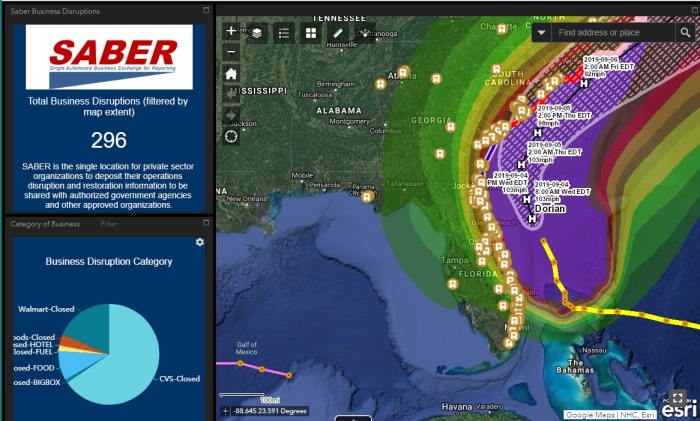U.S Department of Homeland Security (S&T)2020-01-16 12:33:11
US S&T-Funded SABER Helps Communities Get Back to Business During and After Disasters
In recent years, severe storm surges, flooding, mass power outages and other natural or man-made emergencies and disasters have affected businesses in myriad ways. When these disasters strike, the Homeland Security Enterprise relies on real-time data to effectively help businesses, and in turn, private citizens, recover and get back on their feet.
SABER status in an ArcGIS application developed by the U.S. Department of Homeland Security. During the 2019 hurricane season, in the aftermath of Hurricane Barry in Louisiana, the Federal Emergency Management Agency (FEMA) used business status information data to prioritize their response and recovery efforts and determine which organizations needed federal aid. This data was provided by a tool called the Single Automated Business Exchange for Reporting, better known as SABER. Originally created by the private sector, SABER is now a free open-source reporting software, publicly available thanks to funding from the Department of Homeland Security (DHS) Science and Technology Directorate (S&T).
“SABER is a crucial tool for helping organizations maintain or resume their operations both during and after a disaster,” explained DHS S&T Program Manager Ron Langhelm. “Users upload their business status information with the knowledge that federal aid organizations such as FEMA are monitoring SABER and have the resources to immediately respond to and provide aid for any type of crises that they may be experiencing.”
Available both on the web and via a mobile app, SABER provides users with a means to upload and share real-time business status information with other organizations, particularly government aid entities such as FEMA, during an emergency or crisis. Through SABER, organizations can share whether they are open or closed, their location, issues contributing to potential or ongoing closure (e.g. blocked roads, building damage or power outages), resources needed to resume normal operations (e.g. commodities from their supply chain, utilities, or access waivers), and an estimate of time to reopen.
Because all this information is so vital, DHS S&T felt that it should be expanded to include more status and needs data from private businesses. “With our funding and support, SABER is continuing to grow and improve by refining its critical information sharing services and expanding its reach into both the private and public sectors of business and government,” said Langhelm.
When shared with other users—especially FEMA—SABER status data enables responders to prioritize their deployment of effective and tailored responses (e.g., sending resources to fix the roads that enable businesses to reopen and provide supplies to people in need) that can help all organizations maintain or quickly resume their operations and ensure that entire communities are impacted as little as possible by the negative effects of a disaster.
SABER helps its members to continue or resume critical functions both during and after a disaster by:
- communicating their operational status and whether they need any assistance to maintain or resume regular operations;
- helping them specify unmet needs to governments to set priorities and remove obstacles that hinder their ability to operate; and
- allowing them to collaborate with other businesses as well as local, state and federal organizations and aid groups.
One of the highlights of SABER is that it is designed to adapt to differing user capabilities in government and business. Organizations can easily retrieve the data and use it in their own situational awareness and common operating picture applications.
Businesses can easily upload status information to SABER’s secure website and server in three different ways:
- Via automated connection, continuously uploading and sharing business status information in real time;
- Via Excel—If multiple branches have been affected by a disaster, they can upload a spreadsheet that contains business status information about all affected locations; or
- Via mobile app—An individual location can upload its business status information via a SABER-specific mobile app.
SABER Status shown in the SABER mobile app.“Thanks to funding from DHS S&T, SABER is beginning to realize its full potential,” said SABER Executive Director James W. Morentz, Ph.D. “2020 is going to be a big year, as we have an opportunity to design and apply artificial intelligence that will enable SABER to predict whether locations that are geographically close to organizations in our network have been affected by a disaster, and be able to quickly relay that information to relevant organizations in our network, such as FEMA, that can better understand the business forecast and provide aid exactly as needed.”
SABER currently has 130,000 organizations in more than 30 states across the U.S. that utilize its services to report their business status during emergencies. By the end of 2020, both DHS and SABER hope to have 300,000 organizations across the U.S. utilizing SABER to share their business status and provide effective and targeted aid to each other during emergencies and disasters.
“When businesses stay open longer and reopen faster, citizens experience less disruption and whole communities return to normal more effectively,” stated Morentz. “That’s what SABER helps accomplish.”
